Page 100 of 418
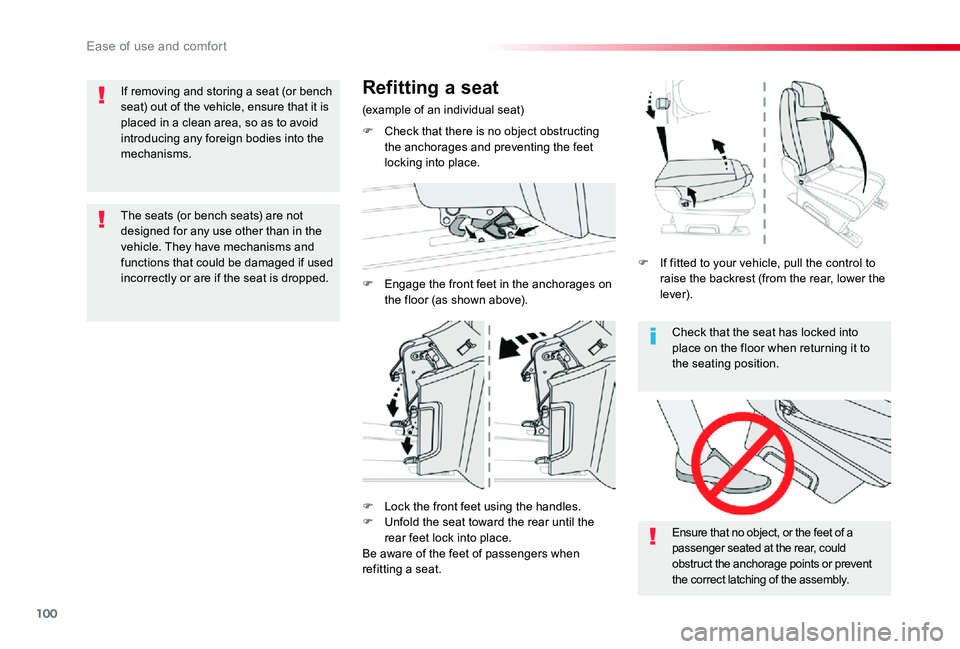
100
Check that the seat has locked into place on the floor when returning it to the seating position.
Ensure that no object, or the feet of a passenger seated at the rear, could obstruct the anchorage points or prevent the correct latching of the assembly.
Refitting a seat
(example of an individual seat)
F Check that there is no object obstructing the anchorages and preventing the feet locking into place.
F Engage the front feet in the anchorages on the floor (as shown above).
F Lock the front feet using the handles.F Unfold the seat toward the rear until the rear feet lock into place.Be aware of the feet of passengers when refitting a seat.
F If fitted to your vehicle, pull the control to raise the backrest (from the rear, lower the lever).
If removing and storing a seat (or bench seat) out of the vehicle, ensure that it is placed in a clean area, so as to avoid introducing any foreign bodies into the mechanisms.
The seats (or bench seats) are not designed for any use other than in the vehicle. They have mechanisms and functions that could be damaged if used incorrectly or are if the seat is dropped.
Ease of use and comfort
Page 103 of 418
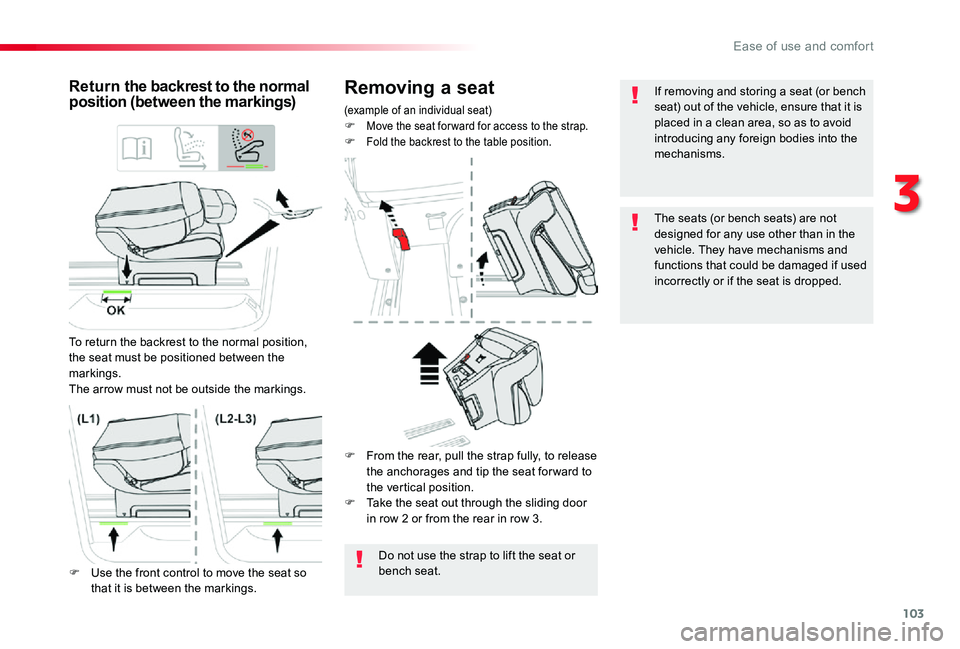
103
Removing a seat
(example of an individual seat)F Move the seat for ward for access to the strap.F Fold the backrest to the table position.
Retur n the backrest to the normal position (between the markings)
To return the backrest to the normal position, the seat must be positioned between the markings.The arrow must not be outside the markings.
Do not use the strap to lift the seat or bench seat.F Use the front control to move the seat so that it is between the markings.
F From the rear, pull the strap fully, to release the anchorages and tip the seat for ward to the vertical position.F Take the seat out through the sliding door in row 2 or from the rear in row 3.
If removing and storing a seat (or bench seat) out of the vehicle, ensure that it is placed in a clean area, so as to avoid introducing any foreign bodies into the mechanisms.
The seats (or bench seats) are not designed for any use other than in the vehicle. They have mechanisms and functions that could be damaged if used incorrectly or if the seat is dropped.
3
Ease of use and comfort
Page 107 of 418
107
Removing a seat
F Move the seat for ward for access to the strap.F Fold the backrest to the table position.
Do not use the strap to lift seat.Do not use the strap to lift the seat.
Before refitting a seat to the vehicle, pull the strap fully to ensure that the latching mechanism has engaged.
F From the rear, pull the strap, going beyond the point of resistance, to free the anchorages and tip the seat for ward to the vertical position.F Take the seat out through the sliding door in row 2 or from the rear in row 3.
Refitting a seatIf removing and storing a seat out of the vehicle, ensure that it is placed in a clean area, so as to avoid introducing any foreign bodies into the mechanisms.
The seats are not designed for any use other than in the vehicle. They have mechanisms and functions that could
be damaged if used incorrectly or are dropped.
3
Ease of use and comfort
Page 109 of 418
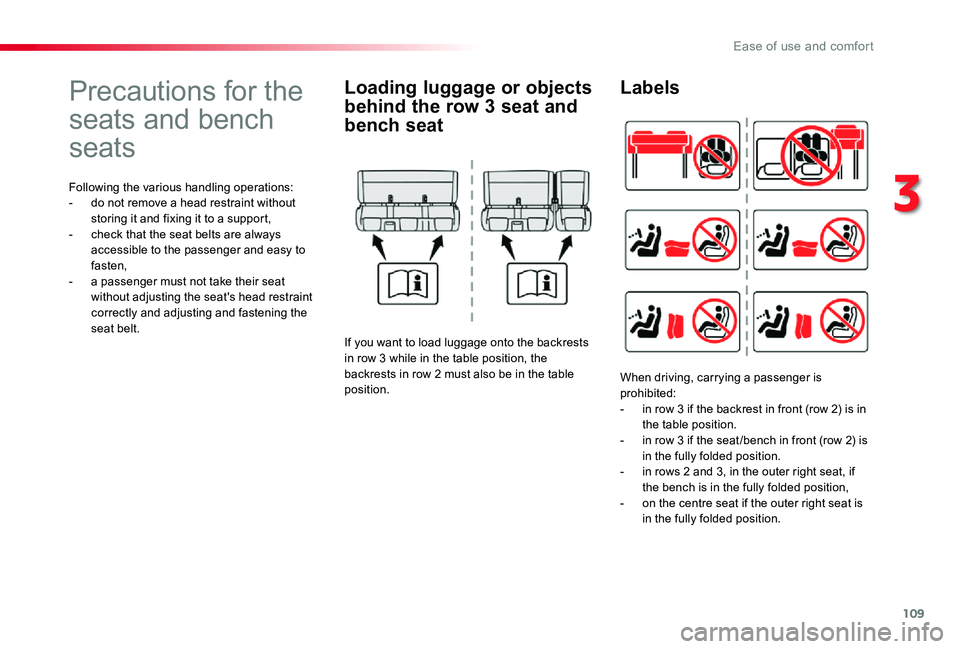
109
Precautions for the
seats and bench
seats
Following the various handling operations:- do not remove a head restraint without storing it and fixing it to a support,- check that the seat belts are always accessible to the passenger and easy to fasten,- a passenger must not take their seat without adjusting the seat's head restraint correctly and adjusting and fastening the seat belt.
Loading luggage or objects
behind the row 3 seat and
bench seat
If you want to load luggage onto the backrests in row 3 while in the table position, the backrests in row 2 must also be in the table position.
Labels
When driving, carrying a passenger is prohibited:- in row 3 if the backrest in front (row 2) is in the table position.- in row 3 if the seat /bench in front (row 2) is in the fully folded position.- in rows 2 and 3, in the outer right seat, if the bench is in the fully folded position,- on the centre seat if the outer right seat is in the fully folded position.
3
Ease of use and comfort
Page 112 of 418
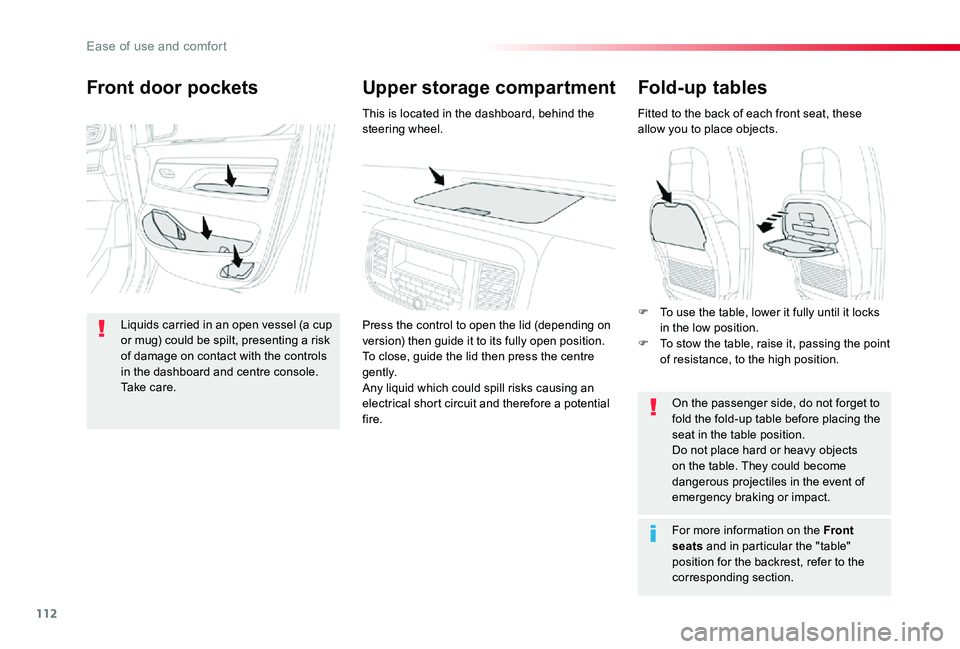
112
Fold-up tables
Fitted to the back of each front seat, these allow you to place objects.
On the passenger side, do not forget to fold the fold-up table before placing the seat in the table position.Do not place hard or heavy objects on the table. They could become dangerous projectiles in the event of emergency braking or impact.
For more information on the Front
seats and in particular the "table" position for the backrest, refer to the corresponding section.
Upper storage compartmentFront door pockets
Liquids carried in an open vessel (a cup or mug) could be spilt, presenting a risk of damage on contact with the controls in the dashboard and centre console. Take care.
This is located in the dashboard, behind the steering wheel.
Press the control to open the lid (depending on version) then guide it to its fully open position.To close, guide the lid then press the centre g e nt l y.Any liquid which could spill risks causing an electrical short circuit and therefore a potential fire.
F To use the table, lower it fully until it locks in the low position.F To stow the table, raise it, passing the point of resistance, to the high position.
Ease of use and comfort
Page 115 of 418
115
Seating area fittings
Depending on the vehicle's equipment, the various fittings below are located in the seating area.
Strap type grab handleCup holder
(depending on version)
Any liquid carried in an open receptacle (cup or other) might be spilt, presenting a risk. Take care.
Nets on the backs of the
front seats
Coat hooks
3
Ease of use and comfort
Page 116 of 418
116
Stowing rings
Use the stowing rings on the rear floor to fix the net, your loads or luggage.
High load retaining net
This allows the use of the entire load space, up to the roof:- behind the front seats in row 1, when the rear seats (and bench seats) in rows 2 and 3 are folded or removed.- behind the rear seats and bench seats in row 2, when the rear seats (and bench seats) in row 3 are folded or removed.
Luggage retaining net
Attached to the stowing rings on the rear floor, it allows objects to be held down.
As a safety measure in the event of sudden braking, it is recommended that heavy objects are placed as far for ward in the vehicle as possible.It is recommended that the load is secured firmly using the stowing rings on the floor.
As a safety measure in the event of sudden braking, it is recommended that heavy objects are placed on the floor as close as possible to the backrest of the seat(s) or bench seat.
Ease of use and comfort
Page 117 of 418
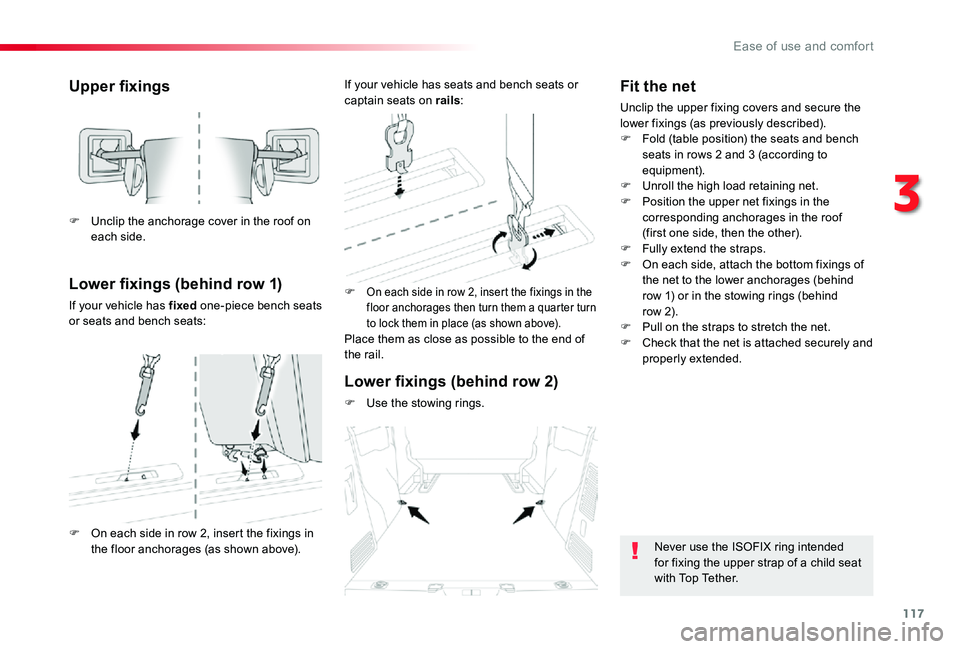
117
Upper fixings
Lower fixings (behind row 1)
If your vehicle has fixed one-piece bench seats or seats and bench seats:
F On each side in row 2, insert the fixings in the floor anchorages then turn them a quarter turn to lock them in place (as shown above).Place them as close as possible to the end of the rail.
F Unclip the anchorage cover in the roof on each side.
F On each side in row 2, insert the fixings in the floor anchorages (as shown above).
If your vehicle has seats and bench seats or captain seats on rails:
Lower fixings (behind row 2)
F Use the stowing rings.
Fit the net
Unclip the upper fixing covers and secure the lower fixings (as previously described).F Fold (table position) the seats and bench seats in rows 2 and 3 (according to equipment).F Unroll the high load retaining net.F Position the upper net fixings in the corresponding anchorages in the roof (first one side, then the other).
F Fully extend the straps.F On each side, attach the bottom fixings of the net to the lower anchorages (behind row 1) or in the stowing rings (behind row 2).F Pull on the straps to stretch the net.F Check that the net is attached securely and properly extended.
Never use the ISOFIX ring intended for fixing the upper strap of a child seat with Top Tether.
3
Ease of use and comfort